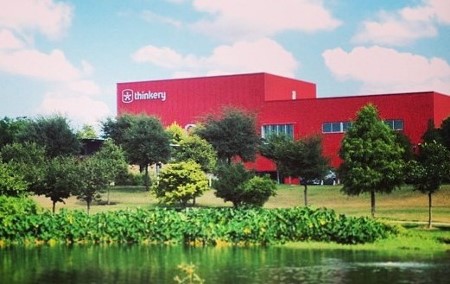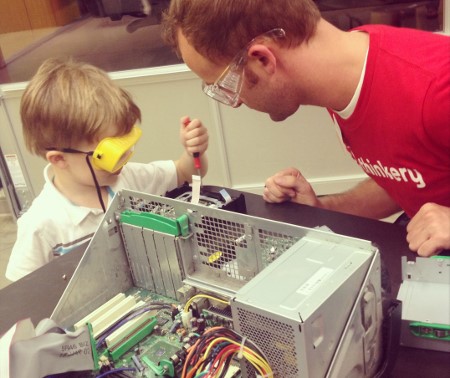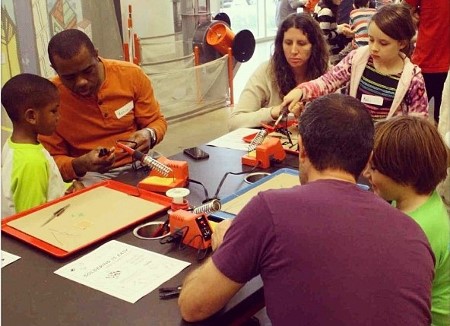More Making at the Thinkery
/Guest contributor Emily Weerts is the Innovators’ Workshop Manager at the Thinkery, the new Austin Children’s Museum. Emily grew up in Northern California and is the daughter of an avid crafter and a handy model maker. A “Maker” before there was a “Movement,” Emily attended the first Maker Faire in California in 2006 before moving that summer to Austin, where she subsequently attended the 2007 and 2008 Austin Maker Faires. Emily dabbles in many Maker pursuits including screen printing, traditional and e-textiles, glass arts, paper crafts, robotics, and kitchen concoctions.
If you’ve been to the Thinkery, you may have noticed the two-story climbing structure or the drenching water exhibit, but before you got to the Light Lab, did you stop by a project table? Maybe you chatted with a resident artist working on a sculpture made from recycled materials. Or perhaps you spent some time tinkering with some LED lights, batteries, and conductive play dough. Did you pop into Kitchen Lab and create something out of corn starch plastic?
Making is a fundamental experience that the Thinkery wants to encourage and share with visitors of all ages.
In 2007 when Maker Faire came to Austin, staff at the Austin Children’s Museum recognized a shared value of learning through Making. In 2008, the Museum partnered to bring an extensive Maker Kids area to the Faire, and in the summer of 2009, the Museum developed and presented a Maker Kids feature exhibit to bring the Maker experience to many more visitors.
In designing the new museum, opportunities for Making and hands-on creative problem solving were at the heart of the planning process. Since the Thinkery opened in late 2013, Making has taken many forms. Visitors stopping in for an hour or two are most likely to encounter Making at the project tables in the Innovators’ Workshop, Spark Shop, and Kitchen Lab.
Here at the Thinkery we define Making broadly and encourage all people to think of themselves as Makers. At its simplest, Making is the act of creating something; from a quilt to a batch of cookies, there are learning opportunities at every step of the way. Making emphasizes skill development, like learning how to properly use a power drill or how to stitch a seam.
When presented in the context of a project, difficult concepts become more manageable. Multiplying fractions makes a bit more sense when done in the service of quadrupling a recipe. Suddenly, while designing a quilt, finding the hypotenuse of a triangle really is as easy as a2 + b2 = c2.
In developing Maker activities and programs at the Thinkery, there are a few guidelines we like to follow. We hope these tips and principles ring true and prove useful for educators everywhere:
- Use real tools. Toys are lots of fun, but there are also many safe ways to introduce real tools to novice learners. Use a wooden mallet instead of a hollow plastic toy hammer. Introduce a three-year-old to stitching by using a yarn needle and plastic canvas.
- It’s okay to fail. No great Maker gets perfect results every time. Far from it! Often the best learning happens during the process of making something and learning from mistakes. Take (calculated) risks, and don’t take yourself too seriously.
- Making takes practice. Learning a new skill can be intimidating, but remember that the best Makers didn’t start out as experts; they had years of practice. With lots of practice, you can be great at anything.
- When people are encouraged and equipped to make things themselves, they gain a strong ownership over their learning. Let the Maker and the project guide the learning process.
- Forget “Do-it-Yourself.” Making is most fun and productive when it’s done with others. Pair novice Makers with Maker Mentors to see how much everyone learns from each other. Let’s start a “Make-it-Together” movement!
- Embrace your own “I don’t know” moments. It’s okay that you don’t know how to solder or use a sewing machine. You can still help learners by colearning, finding resources, or connecting them with Maker Mentors.
- Resist the urge to “do it for them.” Keep your hands off the tools and materials as much as possible. Show learners how to do something and let them try it themselves.
If you aren’t sure where to get started, consider coming up with a Maker Resolution. At the Thinkery, we had all our staff set Maker Resolutions for 2014. Our diverse and creative team came up with a huge spectrum of projects for the new year, from creating a stop-motion animation music video to baking and decorating a three-tiered cake. One of our staff members resolved to learn how to make a website, and one of our Teen Volunteers plans to make her own prom dress.
May this year and all the years to come be filled with creativity, innovation, tinkering, and Making!
Emily Weerts
Join Emily and other Thinkery staff and volunteers on May 3 for some all-ages Making at this year’s Austin Mini Maker Faire!












